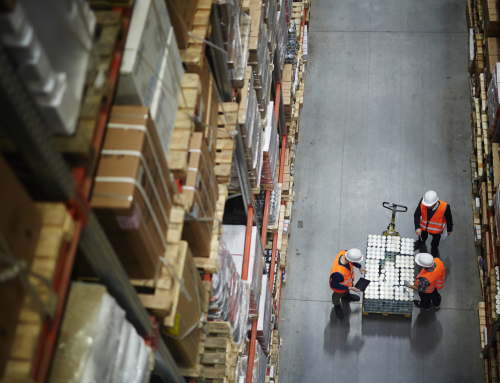A large
manufacturer, an e-commerce retailer, a startup: each can leverage on-demand
warehousing to achieve supply chain flexibility. Here’s how.
The
value of supply chain flexibility has hardly been greater than now. Organizations
that can pivot in response to demand fluctuations, volatile market conditions, changes
in business strategy — any unpredictable event, really — are naturally better equipped
for success.
On-demand
warehousing adds that desired element of supply chain flexibility,
but it’s not a catch-all solution to all inventory challenges. Rather, think of
on-demand warehousing as one of several important
tools to tackle a range of issues and introduce a new level of
supply chain flexibility that you would struggle to achieve in its absence.
But
the question to what extent your product company should use on-demand
warehousing and how improving supply chain flexibility can add value to your
business depends on a variety of factors that we will try to address in this
post.
To
begin identifying which mixture of warehousing solutions that would be the most
beneficial to your business model, ask yourself the following question: “What
supply chain goals do I need my warehouse solution to support?”
Just like an investment portfolio balances
risks and rewards by combining stocks, bonds, and cash, savvy product companies
employ a mix of leased warehouses, 3PLs, and on-demand warehouses to achieve
their supply chain goals. While leased
warehouses typically make up much of the portfolio of a large manufacturer with
an established distribution network, the start-up portfolio looks entirely
different.
Here is a closer look at the
suggested mix of warehouse solutions for three product companies: a large
manufacturer, an e-commerce retailer, and a startup.

Based on their size, location, products,
and goals, why may their portfolios look like this? Let’s explore each in more
detail.
Please note the companies are
fictional.
Large manufacturer
Shoreline Manufacturing, Inc.
Operating
environment: Shoreline has been in business
for 40 years and sales last year hit $42 billion. A national network of
brick-and-mortar stores make up the bulk of sales, although the company has
recently invested in making its online store more user-friendly. Shoreline
has been experiencing steady sales growth over the last five years and its
demand forecast accuracy has consistently been within 5% of actual sales.
Goal: Distribute its electronic goods to
retail stores nationwide at the lowest possible cost within four days
of order.
Constraints: As a Fortune 100 company, capital is not
a constraint. The company has also had many years to establish a
distribution network around the country.
Solution:
80% of Shoreline’s warehouse solutions consists
of a network of leased and company-operated warehouses. This helps the
company lower cost and provides a great degree of control over the bulk of operations
which all run on the same systems.
15% of Shoreline’s warehouse solution is
provided by 3PLs. These are mainly in regions where demand does
not justify the operation of a company-owned facility and where it is
cheaper to use the services of an existing provider.
5% of Shoreline’s warehouse solution is
made up of on-demand warehousing. The flexibility that on-demand
warehousing brings helps the company cope with moderate seasonality and
forecasting errors, as well as occasional issues such as stockpiling for
tariffs and natural disasters that affect its supply chain.
E-Commerce company
Pine Outdoor
Furniture, Inc.
Operating
environment: Pine is
an established e-commerce brand in the competitive outdoor furniture market
with annual sales of $50 million. Given that most of its sales occur during the
warmer months of the year (May-July), the company has to deal with significant
seasonality. Although Pine has experienced moderate sales growth over
the last five years, weather-dependent products mean its demand forecast accuracy
is only within 20% of actual sales. Pine is also stockpiling some inventory
this year in anticipation of additional tariffs being placed on China
where it sources most of its products from.
Goal: Reach 95% customers with one-day shipping.
Constraints: Pine cannot afford to lease and operate
multiple warehouses in many locations to support delivery requirements. The
company also wants to retain
brand control (ship in branded boxes).
Solution:
40% of Pine’s warehouse solution is
provided through facilities that are leased and operated by the company directly.
This helps the company lower cost and gives a great degree of control over the
bulk of operations which all run on the same systems.
40% of Pine’s warehouse solution
is provided by 3PLs. These are mainly in regions where the company
experiences moderate demand and has time to cultivate long-term partnerships
with 3PLs. The company has enough year-round volume in these regions
to keep the 3PLs interested.
20% of Pine’s warehouse solution
is made up of on-demand warehousing. The added supply chain flexibility helps
the company dynamically respond to the issue of summer seasonality and mitigates
the impact of forecasting errors.
Startup
Rent-It, Inc.
Operating environment: Rent-It is an emerging player in the on-demand furniture industry. Millennials are less likely to buy a lot of items, including furniture, compared to previous generations. They rent rather than own their houses and use on-demand services like Uber and Airbnb. Rent-It n extends this business model to furniture, giving customers the ability to rent their apartment. It’s a competitive industry that has received a lot of investment from VC groups in the past few years.
However, the industry has to navigate significant logistics challenges. Moving large items into people’s houses and assembling them requires delivery partners who can pass background checks, interact with customers, and — not to be overlooked — carry furniture up three flights of stairs. In addition, Rent-It’s customers can return the furniture to the warehouse at any time if they move or want to upgrade.
Rent-It’s warehouses also need to be close to metro centers so that they can offer quick delivery.
Goal: Expand into five new metros this year and
offer one-day delivery.
Constraints: The company cannot afford to lease and
operate multiple warehouses in many locations to support delivery requirements.
With no previous footprint, they lack solid sales forecasts, making partnering
with 3PLs difficult as they expand into new metro areas.
Solution:
20% of Rent-It’s warehouse solution is provided by a single leased and company-operated warehouse. The warehouse is located in San Francisco, where the company was founded and where volume supports this kind of facility.
80% of Rent-It’s warehouse solution is provided by on-demand warehousing. The company uses on-demand warehousing as an expansion tool to test offerings in metro areas in a low-risk way (without committing to leases and employees).
What do the goals and constraints look like for your company? How do your current warehouse solutions align with your long-term targets?
We can help you determine whether your business would benefit from adding on-demand warehousing to your portfolio. Contact us today to learn more or schedule a consultation with me, Darrell Jervey, the Warehowz CEO and Founder, below.
Read more:
Infographic:
The warehouse market is primed for innovation



